Triads – in my opinion, are the silent key to mastering the guitar. They are the fundamental building blocks of major and minor chords and serve as the basis for unlocking the power of the entire guitar neck. Harnessing triads takes you from novice to competent in no time.
If you’re reading this, you probably already know how important triads are. But going from strumming five or six-string-chords to strumming just three is tricky. Yet triads are still so popular. You might be wondering, then, how exactly are you supposed to strum them?
To strum triads on the guitar, you’ll have to use a combination of your fingertips and the heel of your palm to mute the unused strings. Also, slow and focused practice while paying careful attention to which strings are muted and which ones aren’t will increase your accuracy and proficiency.
This article will serve as your definitive guide to strumming triads. We’ll break down each step of the necessary techniques and review useful examples of songs that’ll help your technique. Finally, we’ll discuss the best practices and key points to note when it comes to using and learning triads effectively.
The 3 Most Important Tips for Strumming Triads
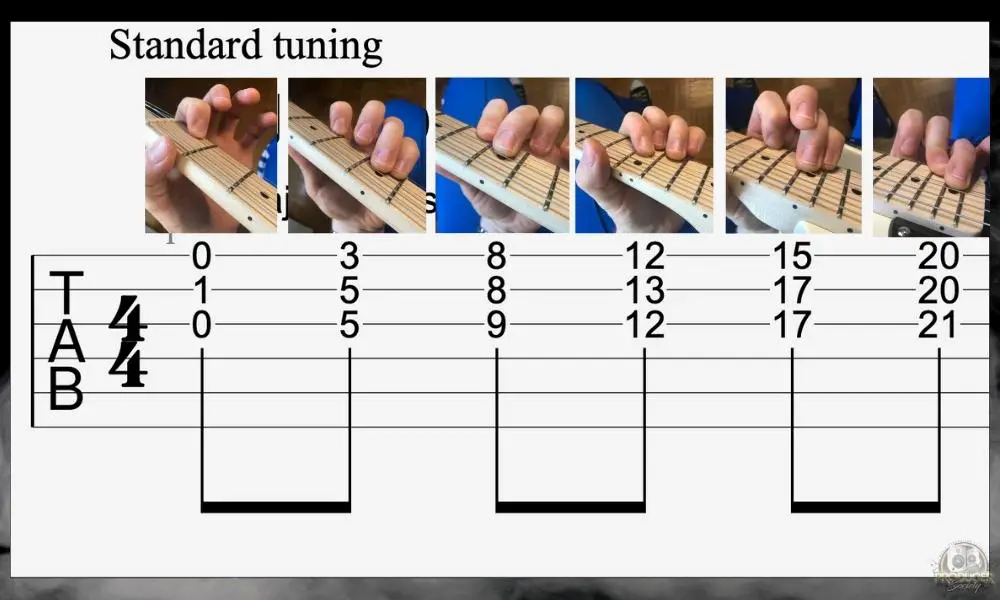
Strumming triads accurately is tricky. Whether it’s the level of wrist control, the precision required with muting the strings, or just the patience needed to accurately fret the chord tones.
But the nice thing about it is you can learn A LOT from strumming triads, not only in terms of your rhythm playing but also in your understanding of the building blocks of harmony which Punkademic explains the best in their music theory course.
I’ve talked about this before in my guide on why learning triads is such a great idea, but I digress. Let’s dive into how we can turn them from intimidating to simple in these easy-to-follow steps.
We’re going to start with the two most important methods which are fretting with your fretting hand and then your palm. Then we’ll talk about wrist control which is also super important.
1) Use Fretting Hand To Mute Surrounding Strings
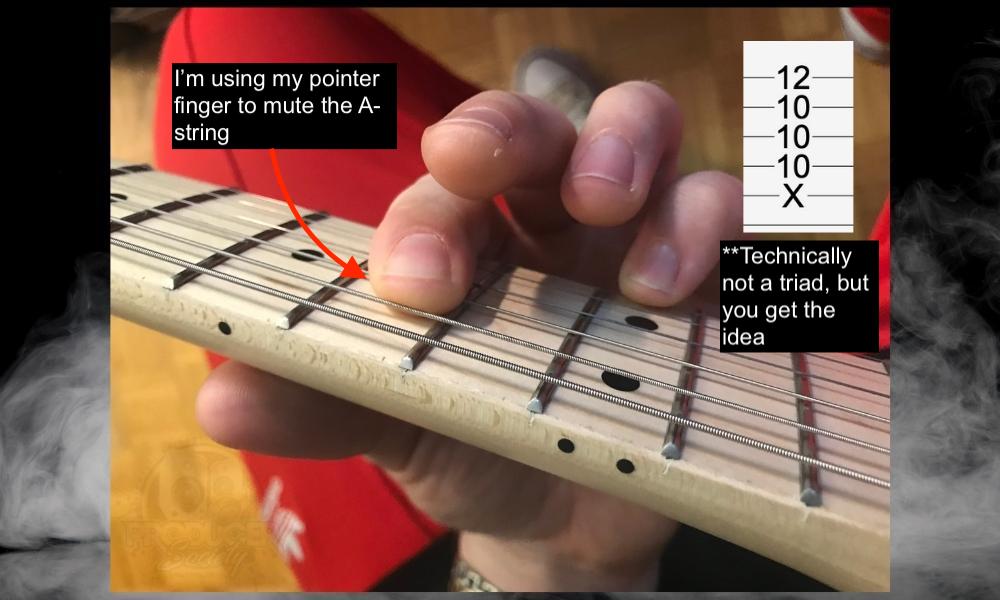
You can use your fretting hand to mute adjacent strings pretty much regardless of what strings you’re playing. It’s just a matter of putting your finger on an angle so it hits the string that you don’t want to play. The picture above is a good example.
Let’s take a G Minor triad, for example, and how it is played. In the first inversion, this chord would require your middle finger on the eighth fret of the D string, your index finger on the sixth fret of the G string, and your ring finger on the eighth fret of the B string.
In this case, you would use your ring finger to mute the high E string, and your middle finger to mute the A string. Rest the tip of your middle finger against the A string while playing in order to mute it effectively. To mute the high E string, rest your ring finger on it while strumming.
Muting the surrounding strings is a good way to allow yourself leeway while strumming triads. This means that you don’t have to worry as much about catching an extra surrounding string while you’re playing.
This method, on its own, plays a huge role in how you strum triads, so don’t take it lightly. It is, in simple terms, the majority of the muting you’ll do. Additionally, when you combine it with selective palm muting, it’s deadly.
2) Mute The Other Strings With Your Palm
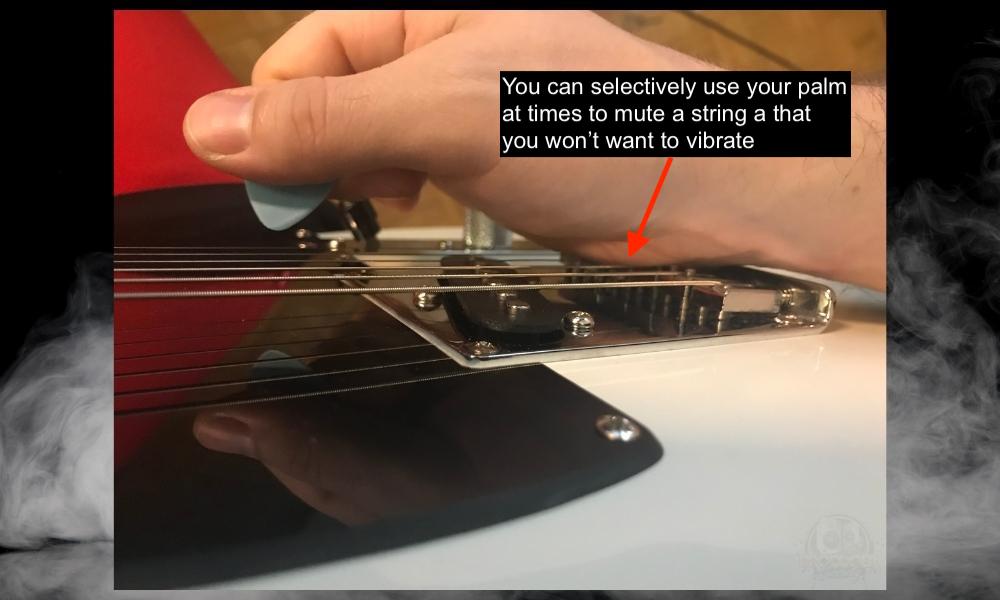
When you are playing major and minor triads that are centered around the 4th, 5th, and 6th strings on the guitar, then part of the way to get a clean sound is to mute the remainder of the strings with your palm.
Palm-muting will not only prevent any unwanted resonance or vibration from adjacent strings, but it will also prevent the sound from the inevitable striking of the other strings. The thing about this is that you can do it where you need to.
For example, sometimes if I strike a string improperly and I can hear it humming in the background, I’ll quickly angle my wrist in such a way that I can mute the vibrating string.
You can do this as much as you’d like, but depending on the riff you’re playing. The same thing can also be done with your fretting hand so keep that in mind.
3) Use Your Wrist and Not Your Arm
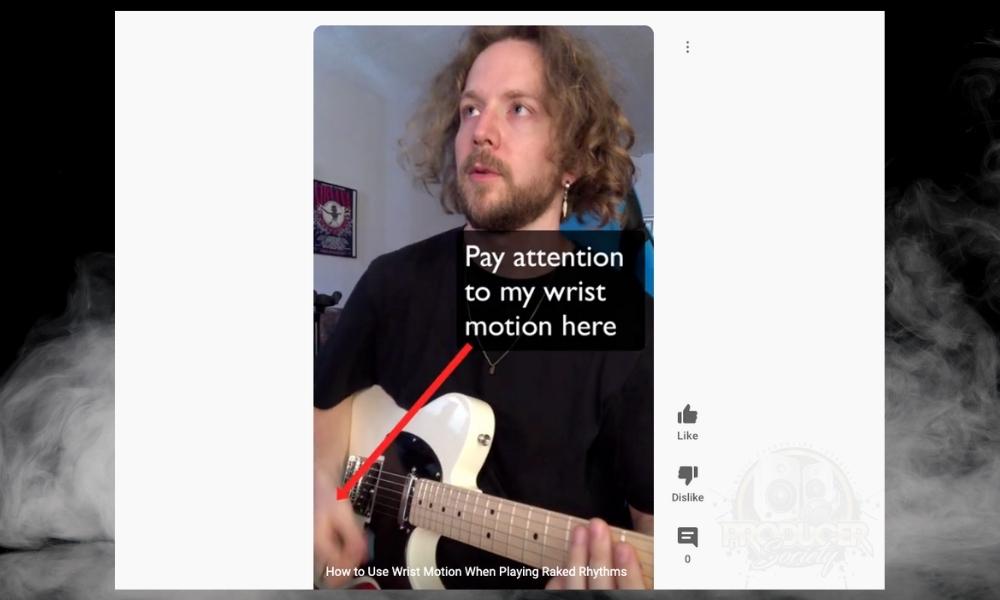
If you’ve read any other articles on this topic, you’ve probably already heard this tip. But I think I have another way of conceptualizing and explaining it to you that will be helpful. For one, let’s actually diagnose if you have the problem or not.
How to Figure Out If You’re Strumming From Your Wrist or Arm
A) Set A Timer for 3 Minutes
B) Set A Metronome at 120 BPM
C) Strum 1/16th Muted Strings for the Full 3 Minutes
Simply put, if you practice 1/16th note strums at 120 beats per minute on the guitar and you find your shoulder, upper back, or neck are getting tired, that’s a sign that you’re using your arm and not your wrist.
If you want to ameliorate this pesky problem, you have to pay careful attention to how you’re strumming. Focus on relaxing your arm and strumming from the wrist, and not from your elbow or any other part of your body.
Continue performing the test that I just showed you until you’re fully capable of strumming 1/16th muted notes at 120 BPM without getting tired. This is an important thing to master regardless of whether you’re playing triads, full chords, or even alternate picking.
7 Tips for Learning to Strum Triads
1) Start Slow – Build Up To Strumming Fast
One of the key rules of thumb when it comes to your guitar practice is to start off slowly before you build up speed and try to play a song at full pace. I do this every single day.
It’s a classic temptation that we’ve all fallen prey to. We try to learn a new riff or a new song, and we want to master it as quickly as possible. As a result, we end up rushing the practice process and as we play the individual notes it sounds clunky and messy.
The problem is, if you keep forcing yourself to play quickly through these mistakes, then that’s what your hands will get accustomed to playing. You’ll just be very good at making those mistakes.
A wise man once said to me that practice makes permanent, and not necessarily perfect. With my practice, I like to remember an old adage that is generally attributed to the US Navy Seals: Slow is smooth. Smooth is fast.
It sounds nonsensical, but it makes perfect sense. We have to start our practice slowly so that it can be smooth. Only once it’s smooth, can it be fast.
This is something that Joseph Alexander argues in his book on Funk Guitar Mastery. As a matter of fact, the exercise that I’ll give to you at the end is partially inspired by something I learned from his book and I’m still practicing to this day.
2) Play Triads On Strings That Are Close to Each Other
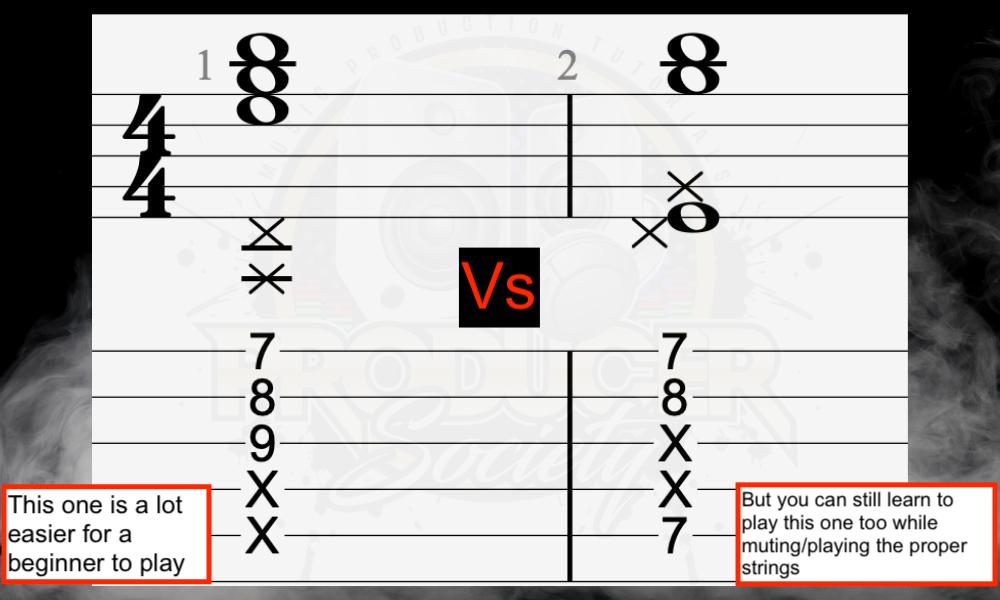
Since triads are effectively just three notes that make up a chord, it is possible to create these combinations in any structure (here’s my guide on memorizing them by the way).
However, the best way to ensure that you play your triads accurately and more easily is to group them on strings that are close to each other.
For example, if you are constructing a G major triad, you can feasibly have three notes that are relatively far apart from one another. You could have the tenth fret of the A string for your G note, the open B string for your B note, and the tenth fret of the E string for your D note.
Of course, in the technical sense, these three notes do form a G major triad. But the way in which the chord is constructed makes it much more difficult to strum without any mistakes or rogue notes coming into play.
A more effective way to construct this triad would be the tenth fret of the E string, the 12th fret of the D string, and the 12th fret of the B string. This way, all three strings required for your triad will be alongside one another, making it easier to strum with precision.
Tip
One thing I should say though is that you don’t have to do this forever. Once you’ve really developed your left and right-hand technique, you can play chords and triads with whatever notes that you want.
3) Make Sure You’re Using the Right Pick
As I’ve said in my guide to strumming on the guitar, you want to make sure that you’re using a pick that will best serve that purpose. Different picks work best according to whether you’ll be strumming or picking.
In this case, especially as you’re starting out, thinner picks will work better. 0.65mm is a good thickness when you’re strumming triads, in my opinion, but most teachers will tell you that the thinner the better.
My favorite for strumming on the guitar is the 0.65mm BULB Delrin pick which you can see right here.

The pick is just thick enough so that intentional strums on the three strings of the triads will be rich, but there’s also sufficient play where you can breeze through the other strings if you need to.
Additionally, this pick can be used for shredding or faster alternate picking. It’s a nice happy medium between a pick that’s great for fast playing and strumming.
That said, it doesn’t have to be this exact pick. The way I look at it, the pick thickness, texture, and shape are usually more important than the material or brand.
4) Roll Off Tone or Volume Knob If There Is Too Much Attack
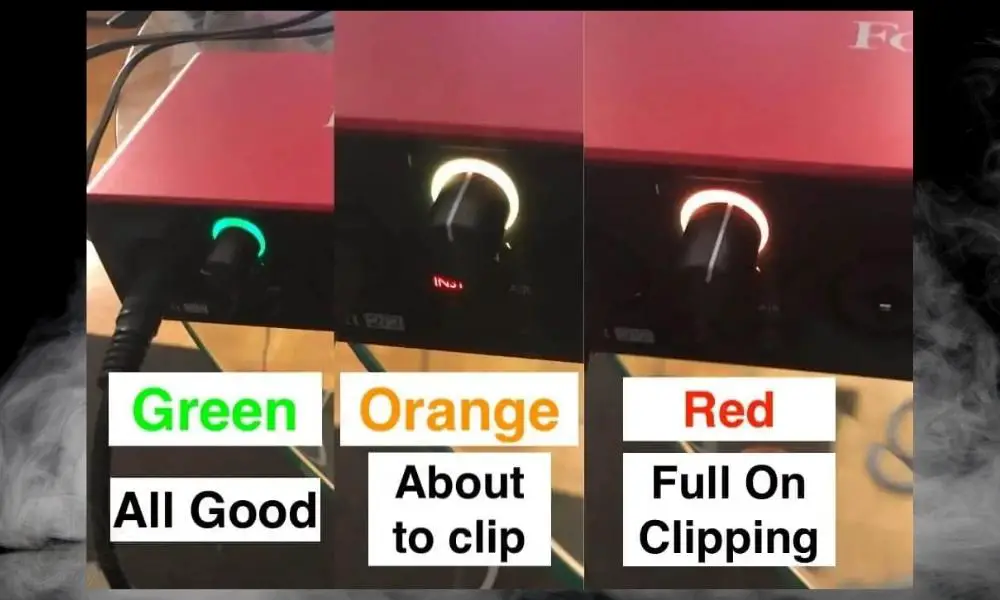
Sometimes, despite how softly you might seem to be strumming, it can seem like there is too much sharpness in your tone and this can cause mistakes to be emphasized.
Try to lower the gain to mitigate the attack on your strumming and achieve a smoother sound. A harsh tone isn’t going to inspire you. It’s going to make you less likely to continue playing because the strums and mutes will be too much.

This is also a problem if you’re running a really hot signal into a DAW, as well. For example, if I’m using my Scarlett 2i2, I’ll either have to roll the pickups off a bit or turn down the gain on the audio interface.
Strumming has quite a bit of attack, so it’s easy to cause clipping and other problems. Roll down the volume on your pickups by 25% maybe, and see how that sounds. You may find you get a much nicer and more fluid pick attack.
5) Don’t Hold the Pick So Hard
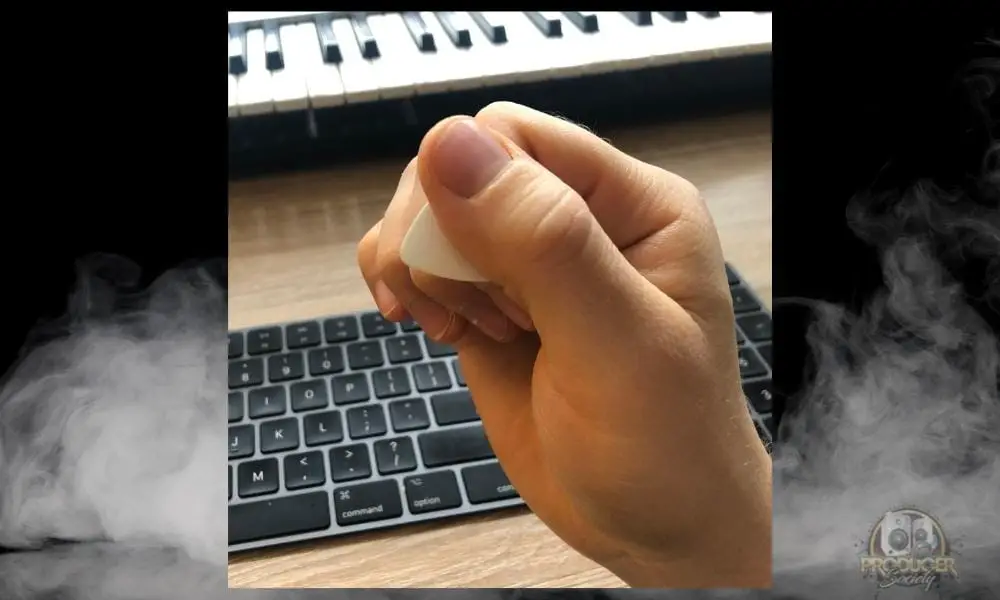
If you want to strum triads and other chords fast, rhythmically, and with accuracy and precision, there’s a certain level of effortlessness or lightness that you need. In other words, the harder you hold your pick, and the more effort you put into it, the worse it gets.
Coupled with a relatively thin pick (0.55mm – 0.65mm) and moving primarily from your wrist and not your arm, you can get into the rhythm without sacrificing energy.
You want to hold your pick firmly enough so you don’t drop it, but not so hard that you can’t strum properly. There’s a delicate balance there. Remember to do as I said before and start slow.
6) Use Hybrid Picking To Be More Accurate
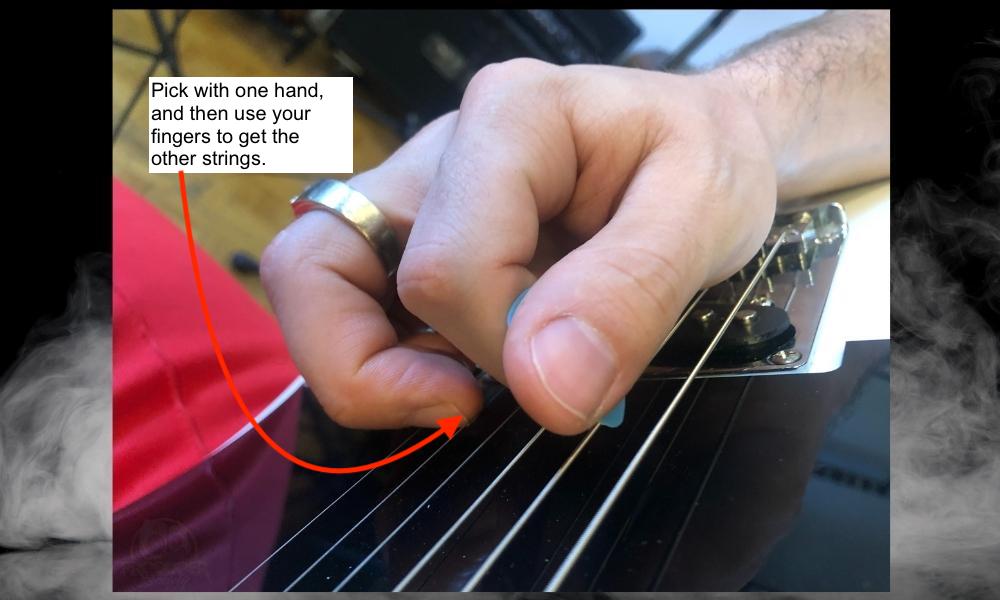
While hybrid picking isn’t necessarily “strumming,” it can be used in conjunction with strumming. You can switch between the two well if you practice it enough, and it’s not uncommon for certain players to do this.
One of the ways that you can increase your accuracy is with hybrid picking. Hybrid picking simply refers to a technique that sees you use a combination of your pick and your fingers on your right hand when playing guitar.
This could be an entire article in itself, but we’ll briefly explore it here. Here’s how to hybrid pick effectively. First, you’ll hold your pick as normal between your index finger and your thumb.
The pick will be positioned between these fingers as if you are turning a key. The remaining three fingers will be used to pluck the strings upwards as your guitar pick strokes will mostly go downwards.
With hybrid picking, you will have the ability to pluck all three notes of your triad simultaneously. You will also be able to play your arpeggios with more accuracy as you maintain a specific allocation of your pick to one string, and each finger to its own string as well.
Playing arpeggios with your triads becomes more accessible with hybrid picking, but you are not only limited to arpeggios. Since you still have your pick, you can continue strumming with your pick once a particular arpeggio section is over.
Hybrid picking also goes by the name chicken picking because of its association with bluegrass and country/western styles. It can be super cool when used well.
7) Look To Funk or Rock Guitarists For Inspiration
Seventies Funk and eighties rock are great places to look when it comes to using triads effectively. Triads have been so popular that you’ll be able to easily find examples of songs that apply the techniques we have discussed.
We’ll go through some examples below. Additionally, I’ll give you a few ideas for how you may want to practice your strummed triads.
Songs to Learn If You Want to Practice Strumming Triads
“Higher Ground” from Red Hot Chili Peppers
RHCP’s reworking of the Stevie Wonder classic is a good song to practice triad strumming as well as the occasional individual picking in between.
Some of the techniques that you will practice here are the muting of adjacent strings as well as precisely strumming two or three strings without hitting the others. Personally, I find playing this song pretty challenging because it requires quite a bit of accuracy.
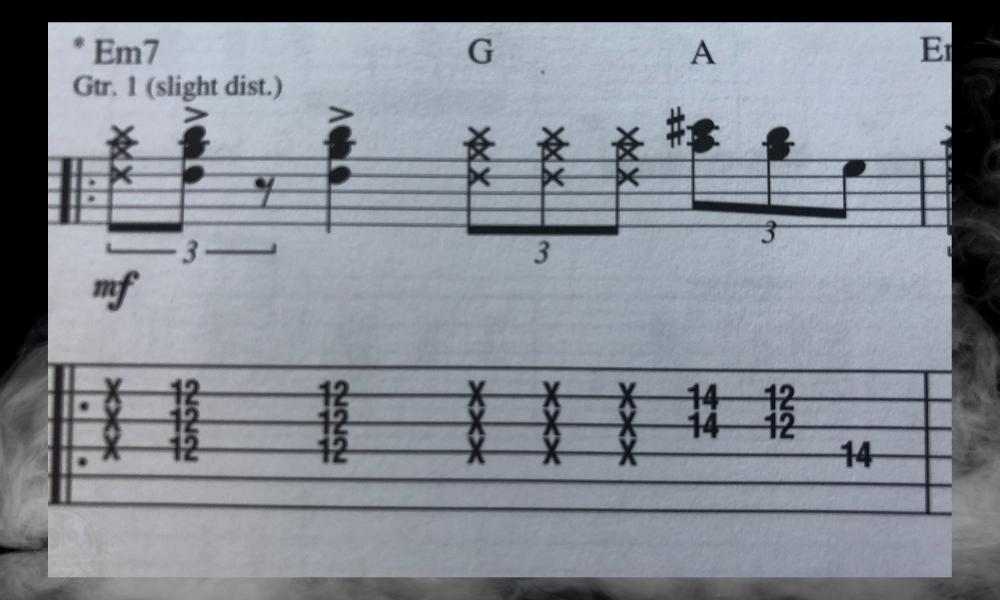
The verses will see you playing an open E string, with your index finger on the second fret of the A and D strings to form an E5(power chord). Although not a triad, you still have to precisely strum the lowest three strings to get that grungy sound.
You’ll then move onto a G power chord with the third fret of the E string, and the fifth fret of the A and D strings. Finally, you’ll slide over to an A power chord with the fifth fret of the A string, and the seventh fret of the A and D strings.
Where the song really gets into the techniques we discussed is in the breaks. Here, you will have to accurately play the 14th and 15th frets of the G and B strings respectively.
In order to do this, you will have to use the tip of your ring finger to mute the D string by lightly touching it.
You will also have to mute the high E string by gently resting your pinky finger on it as you strum. Finally, focus on precisely strumming these two strings, while muting the others.
“The Payback” from James Brown
Jimmy Nolen, the famed guitarist who shared the stage most frequently with James Brown, used triads as the base in his playing but added that saucy funk element by extending the chords with their 9ths or 11ths.
I keep going back to the point that knowing triads serves multiple purposes. Being the base of chords, they offer you an opportunity to handily extend them to add funky tones and venture into new genres too.
This song is a great demonstration of the power of restraint and simplicity especially when you’re playing along with a big band. There are hardly any notes in the guitar part, and you’ll be able to practice strumming on a few strings.
“Roxanne” from The Police
Much of the late 70s and early 80s were popularised by subtle genre-bending crossovers. This momentous hit by The Police is driven by tastefully chosen triads in root position and various inversions. You’ll mostly stay on the G, B, and high E strings and it’s great for practice.
Andy Summers starts this groove off with a G minor triad in the first inversion for the intro. This sees you use your index finger to bar the third fret of the G, B, and high E strings (check the tab here – it’s pretty accurate).
This gives you the note Bb on the G string, the note D on the B string, and the note G on the high E string. For more freedom with your strumming, you’ll be able to use the tip of your index finger to mute the D string, as we discussed earlier.
For the verse, you’ll repeat the G minor triad, and then move on to a D minor triad. Your index finger should be on the first fret of the high E string, your middle finger on the second fret of the G string, and your ring finger on the third fret of the B string.
You can find the rest of the tutorial for this song in this in-depth video by Ry Naylor Guitar on YouTube. But you can see from what I’ve written so far, that you’ll have an awesome time practicing chords that are a lot like triads.
TomoJustFunky on TikTok and TomoFujita on YouTube
Tomo Fujita is a great resource for guitar lessons, particularly on rhythm playing and strumming. Of course, he teaches many other valuable things as well, but what I like his content for is his rhythm primarily and how he teaches it.
How Do You Use Triads for Rhythm Guitar?
1) Practice 1/4, 1/8, 1/16 & 1/32 Note Divisions At Slow and Fast BPMs
Wrist movement and speed with your triads are the keys to playing triads in particular styles, especially funk, but many other genres as well. Don’t overthink this. After you’ve memorized the triads in a particular key, you can practice with this exercise.
A) Choose a BPM And Down Pick 1/4 Notes
75 BPM is a great place to start, and then practice strumming 1/4 notes exactly so that each down pick hits at the same time as the metronome. Every four beats, switch to a new triad in the scale and focus on matching the down pick with the metronome.
For instance, start with the C Major and all 6 versions of it on the top 3 strings. Then after 4 bars have passed, go to D Minor, and then 4 bars of E Minor, and then 4 bars of F Major, etc.
B) Switch to 1/8 Notes
Switch to 1/8 notes and then do up and down strumming, but continue matching the down pick with the metronome click. Change the triad to the next chord in the scale with every 4 bars that pass.
C) Switch to 1/16 Notes
Finally, go to 1/16 notes and continue accenting on the down pick at the same time as the metronome click.
D) Increase the BPM By 8 Once You’ve Become Comfortable
Once you’ve found yourself feeling pretty comfortable at this speed, go ahead and turn the speed up by 8 BPM.
E) Drop the BPM Down to 40 – You’ll Learn A Lot At Slower Speeds
Repeat this process until you’re all the way up to 120 BPM. Also, give 40 BPM a shot, because you’ll learn a lot at this speed. Practicing at a slower BPM is actually harder because there is more space between the notes.
As you practice your triads, be sure to go through playing different note lengths at different tempos. Start slow, and increase your speed as your accuracy improves.
Important Things to Note About Strumming Triads
1) There Are Other Ways to Learn, Memorize, and Practice Triads
There’s not just one particular way to go about learning triads. They tie into so many other elements of music theory that you can approach this part of your journey in multiple ways.


 Written By :
Written By :
